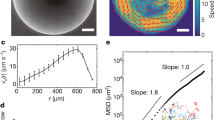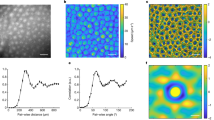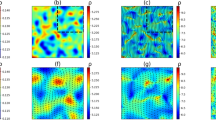Abstract
Despite their inherently non-equilibrium nature1, living systems can self-organize in highly ordered collective states2,3 that share striking similarities with the thermodynamic equilibrium phases4,5 of conventional condensed-matter and fluid systems. Examples range from the liquid-crystal-like arrangements of bacterial colonies6,7, microbial suspensions8,9 and tissues10 to the coherent macro-scale dynamics in schools of fish11 and flocks of birds12. Yet, the generic mathematical principles that govern the emergence of structure in such artificial13 and biological6,7,8,9,14 systems are elusive. It is not clear when, or even whether, well-established theoretical concepts describing universal thermostatistics of equilibrium systems can capture and classify ordered states of living matter. Here, we connect these two previously disparate regimes: through microfluidic experiments and mathematical modelling, we demonstrate that lattices of hydrodynamically coupled bacterial vortices can spontaneously organize into distinct patterns characterized by ferro- and antiferromagnetic order. The coupling between adjacent vortices can be controlled by tuning the inter-cavity gap widths. The emergence of opposing order regimes is tightly linked to the existence of geometry-induced edge currents15,16, reminiscent of those in quantum systems17,18,19. Our experimental observations can be rationalized in terms of a generic lattice field theory, suggesting that bacterial spin networks belong to the same universality class as a wide range of equilibrium systems.
This is a preview of subscription content, access via your institution
Access options
Subscribe to this journal
Receive 12 print issues and online access
$259.00 per year
only $21.58 per issue
Buy this article
- Purchase on SpringerLink
- Instant access to full article PDF
Prices may be subject to local taxes which are calculated during checkout



Similar content being viewed by others
References
Schrödinger, E. What is Life? (Cambridge Univ. Press, 1944).
Vicsek, T. & Zafeiris, A. Collective motion. Phys. Rep. 517, 71–140 (2012).
Marchetti, M. C. et al. Hydrodynamics of soft active matter. Rev. Mod. Phys. 85, 1143–1189 (2013).
Kardar, M. Statistical Physics of Fields (Cambridge Univ. Press, 2007).
Mermin, N. D. The topological theory of defects in ordered media. Rev. Mod. Phys. 51, 591–648 (1979).
Ben Jacob, E., Becker, I., Shapira, Y. & Levine, H. Bacterial linguistic communication and social intelligence. Trends Microbiol. 12, 366–372 (2004).
Volfson, D., Cookson, S., Hasty, J. & Tsimring, L. S. Biomechanical ordering of dense cell populations. Proc. Natl Acad. Sci. USA 150, 15346–15351 (2008).
Riedel, I. H., Kruse, K. & Howard, J. A self-organized vortex array of hydrodynamically entrained sperm cells. Science 309, 300–303 (2005).
Dunkel, J. et al. Fluid dynamics of bacterial turbulence. Phys. Rev. Lett. 110, 228102 (2013).
Wu, J., Roman, A.-C., Carvajal-Gonzalez, J. M. & Mlodzik, M. Wg and Wnt4 provide long-range directional input to planar cell polarity orientation in drosophila. Nature Cell Biol. 15, 1045–1055 (2013).
Katz, Y., Ioannou, C. C., Tunstro, K., Huepe, C. & Couzin, I. D. Inferring the structure and dynamics of interactions in schooling fish. Proc. Natl Acad. Sci. USA 108, 18720–18725 (2011).
Cavagna, A. et al. Scale-free correlations in starling flocks. Proc. Natl Acad. Sci. USA 107, 11865–11870 (2010).
Sanchez, T., Chen, D. T. N., DeCamp, S. J., Heymann, M. & Dogic, Z. Spontaneous motion in hierarchically assembled active matter. Nature 491, 431–434 (2012).
Sokolov, A. & Aranson, I. S. Physical properties of collective motion in suspensions of bacteria. Phys. Rev. Lett. 109, 248109 (2012).
Wioland, H., Woodhouse, F. G., Dunkel, J., Kessler, J. O. & Goldstein, R. E. Confinement stabilizes a bacterial suspension into a spiral vortex. Phys. Rev. Lett. 110, 268102 (2013).
Lushi, E., Wioland, H. & Goldstein, R. E. Fluid flows created by swimming bacteria drive self-organization in confined suspensions. Proc. Natl Acad. Sci. USA 111, 9733–9738 (2014).
Büttiker, M. Absence of backscattering in the quantum Hall effect in multiprobe conductors. Phys. Rev. B 38, 9375–9389 (1988).
Kane, C. L. & Mele, E. J. Quantum spin Hall effect in graphene. Phys. Rev. Lett. 95, 226801 (2005).
Castro Neto, A. H., Guinea, F., Peres, N. M. R., Novoselov, K. S. & Geim, A. K. The electronic properties of graphene. Rev. Mod. Phys. 81, 109–162 (2009).
Wilson, K. G. Confinement of quarks. Phys. Rev. D 10, 2445–2459 (1974).
Glendenning, N. K. Compact Stars: Nuclear Physics, Particle Physics, and General Relativity (Springer, 2000).
Battye, R. A. & Sutcliffe, P. M. Skyrmions with massive pions. Phys. Rev. C 73, 055205 (2006).
Nagaosa, N. & Tokura, Y. Topological properties and dynamics of magnetic skyrmions. Nature Nanotech. 8, 899–911 (2013).
Novoselov, K. S. et al. Two-dimensional gas of massless Dirac fermions in graphene. Nature 438, 197–200 (2005).
Drut, J. E. & Lähde, T. A. Lattice field theory simulations of graphene. Phys. Rev. B 79, 165425 (2009).
Fernández, R., Fröhlich, J. & Sokal, A. D. Random Walks, Critical Phenomena, and Triviality in Quantum Field Theory (Springer, 1992).
Woodhouse, F. G. & Goldstein, R. E. Spontaneous circulation of confined active suspensions. Phys. Rev. Lett. 109, 168105 (2012).
Vaks, V. G., Larkin, A. I. & Ovchinnikov, Y. N. Ising model with interaction between non-nearest neighbors. Sov. Phys. JETP 22, 820–826 (1966).
Stephenson, J. Ising model with antiferromagnetic next-nearest-neighbor coupling: spin correlations and disorder points. Phys. Rev. B 1, 4405–4409 (1970).
Abo-Shaeer, J. R., Raman, C., Vogels, J. M. & Ketterle, W. Observation of vortex lattices in Bose–Einstein condensates. Science 292, 476–479 (2001).
Acknowledgements
We thank V. Kantsler and E. Lushi for assistance and discussions. This work was supported by European Research Council Advanced Investigator Grant 247333 (H.W. and R.E.G.), EPSRC (H.W. and R.E.G.), an MIT Solomon Buchsbaum Fund Award (J.D.) and an Alfred P. Sloan Research Fellowship (J.D.).
Author information
Authors and Affiliations
Contributions
All authors designed the research and collaborated on theory. H.W. performed experiments and PIV analysis. H.W. and F.G.W. analysed PIV data and performed parameter inference. F.G.W. and J.D. wrote simulation code. All authors wrote the paper.
Corresponding author
Ethics declarations
Competing interests
The authors declare no competing financial interests.
Supplementary information
Supplementary Movie 1
Supplementary Movie (MOV 17940 kb)
Supplementary Movie 2
Supplementary Movie (MOV 20802 kb)
Supplementary Movie 3
Supplementary Movie (MOV 5829 kb)
Supplementary Movie 4
Supplementary Movie (MOV 17069 kb)
Rights and permissions
About this article
Cite this article
Wioland, H., Woodhouse, F., Dunkel, J. et al. Ferromagnetic and antiferromagnetic order in bacterial vortex lattices. Nature Phys 12, 341–345 (2016). https://doi.org/10.1038/nphys3607
Received:
Accepted:
Published:
Issue date:
DOI: https://doi.org/10.1038/nphys3607
This article is cited by
-
Active hydraulics laws from frustration principles
Nature Physics (2024)
-
Spatial biology of Ising-like synthetic genetic networks
BMC Biology (2023)
-
Non-orientable order and non-commutative response in frustrated metamaterials
Nature (2023)
-
Autonomous waves and global motion modes in living active solids
Nature Physics (2023)
-
Spontaneous vortex formation by microswimmers with retarded attractions
Nature Communications (2023)



